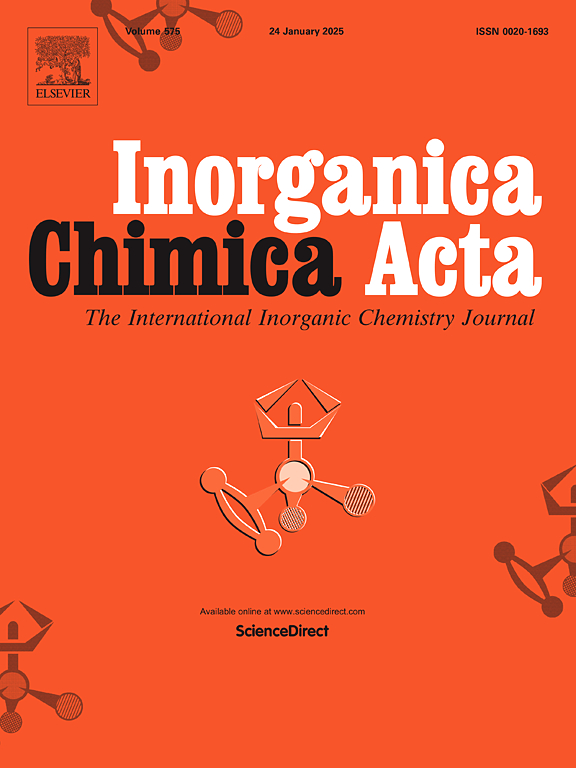与环硒化物(DHSred)形成无细胞毒性的顺铂类似物:缓解顺铂诱导毒性的建议策略
IF 3.2
3区 化学
Q2 CHEMISTRY, INORGANIC & NUCLEAR
引用次数: 0
摘要
合成了由铂(II)与环硒化物反式3,4-二羟基硒烯烷(DHSred)络合而成的顺铂类似物。通过微量分析、核磁共振(1H, 13C{1H}, 77Se{1H}和195Pt{1H})、红外光谱、拉曼光谱和紫外-可见光谱对其进行了表征,并通过单晶x射线衍射分析得到其分子结构为cis-[PtCl2(DHSred)2]. h2o。DSC分析结果显示,该基因不存在多态性,但在温度范围 − 25 ~ 80 °C内以单一异构体形式存在。顺式- (PtCl2 (DHSred) 2]。研究了H2O对皮肤(A431)、乳腺(SKBR3)、肺(A549)和脑(LN229)来源的人癌细胞的细胞毒性。与标准的水化顺铂相比,DHSred表现出明显的低细胞毒性,并且DHSred本身被发现是无细胞毒性的。这一观察结果指导我们设计顺铂化疗后的DHSred治疗策略,以清除积聚在细胞特别是肾脏系统中的过量顺铂,以改善顺铂的严重副作用。为了评价这一点,我们原位合成了顺式-[Pt(NH3)2(DHSred)2]Cl2配合物,与顺铂相比,该配合物也表现出非常低的细胞毒性。结果表明,过量的高毒性水化顺铂可以转化为无毒的顺铂类似物,即顺式-[Pt(NH3)2(DHSred)2]Cl2,有望克服由于顺铂积累而产生的严重副作用。此外,进行DFT计算来研究几何和电子结构,以将其与观察到的高度降低的顺式-[PtCl2(DHSred)2]的细胞毒性联系起来。H2O和顺式-[Pt(NH3)2(DHSred)2]Cl2配合物与顺铂的比较。本文章由计算机程序翻译,如有差异,请以英文原文为准。

Formation of non-cytotoxic cisplatin analogues with a cyclic selenide (DHSred): a proposed strategy for alleviation of cisplatin-induced toxicity
Cisplatin analogue consisting of platinum(II) complexed with a cyclic selenide, trans 3,4-dihydroxy selenolane (DHSred) was synthesized. It was characterized by microanalyses, NMR (1H, 13C{1H}, 77Se{1H} and 195Pt{1H}), FT-IR, Raman and UV–Vis spectroscopy and its molecular structure was obtained by a single crystal X-ray diffraction analysis as cis-[PtCl2(DHSred)2].H2O. It was evaluated for existance of polymorphism by DSC analysis which revealed the absence of any polymorphism but it exists as a single isoform in a temperature range − 25 to 80 °C. The cis-[PtCl2(DHSred)2].H2O was evaluated for its cytotoxicity against human cancer cell lines from skin (A431), breast (SKBR3), lung (A549) and brain (LN229) origin. It exhibited a significantly low cytotoxicity as compared with a standard aquated cisplatin as well as DHSred itself was found to be non-cytotoxic. This observation directed us to design a strategy of DHSred treatment after cisplatin chemotherapy to remove the excess of cisplatin accumulated in cells especially in renal system in order to ameliorate the severe side effects of cisplatin. To evaluate this, we have synthesized the cis-[Pt(NH3)2(DHSred)2]Cl2 complex in-situ by reacting aquated cisplatin with DHSred and this complex also exhibited very poor cytotoxicity as compared to cisplatin. It revealed, that the excess of highly toxic aquated cisplatin could be converted to a nontoxic cisplatin analogue i.e., cis-[Pt(NH3)2(DHSred)2]Cl2 which is anticipated to overcome the severe side effects, because of cisplatin accumulation. Additionally, the DFT calculations were performed to study geometrical and electronic structures to correlate these with the observed highly decreased cytotoxicity of cis-[PtCl2(DHSred)2].H2O and cis-[Pt(NH3)2(DHSred)2]Cl2 complexes in comparison with cisplatin.
求助全文
通过发布文献求助,成功后即可免费获取论文全文。
去求助
来源期刊

Inorganica Chimica Acta
化学-无机化学与核化学
CiteScore
6.00
自引率
3.60%
发文量
440
审稿时长
35 days
期刊介绍:
Inorganica Chimica Acta is an established international forum for all aspects of advanced Inorganic Chemistry. Original papers of high scientific level and interest are published in the form of Articles and Reviews.
Topics covered include:
• chemistry of the main group elements and the d- and f-block metals, including the synthesis, characterization and reactivity of coordination, organometallic, biomimetic, supramolecular coordination compounds, including associated computational studies;
• synthesis, physico-chemical properties, applications of molecule-based nano-scaled clusters and nanomaterials designed using the principles of coordination chemistry, as well as coordination polymers (CPs), metal-organic frameworks (MOFs), metal-organic polyhedra (MPOs);
• reaction mechanisms and physico-chemical investigations computational studies of metalloenzymes and their models;
• applications of inorganic compounds, metallodrugs and molecule-based materials.
Papers composed primarily of structural reports will typically not be considered for publication.
 求助内容:
求助内容: 应助结果提醒方式:
应助结果提醒方式:


